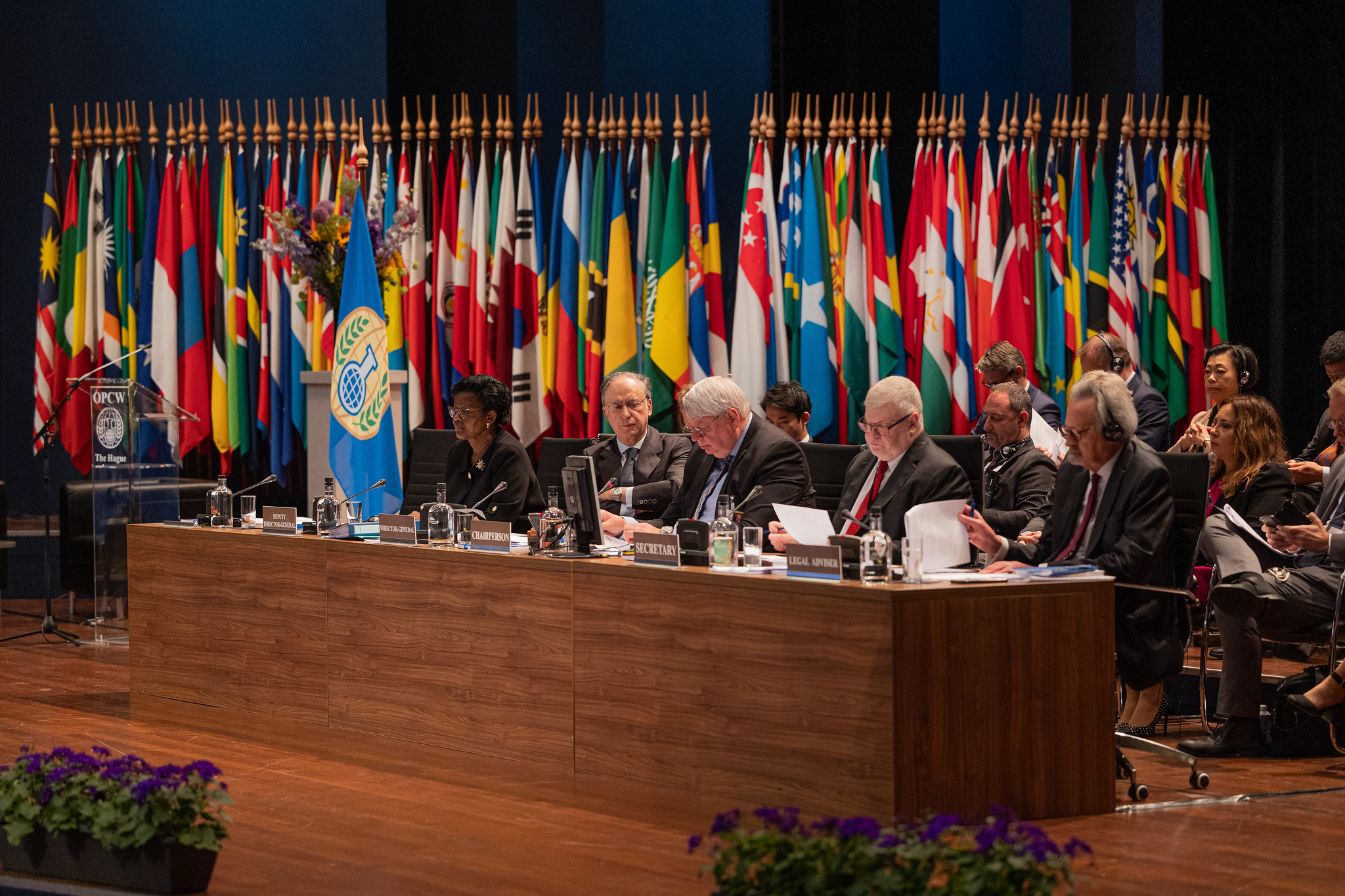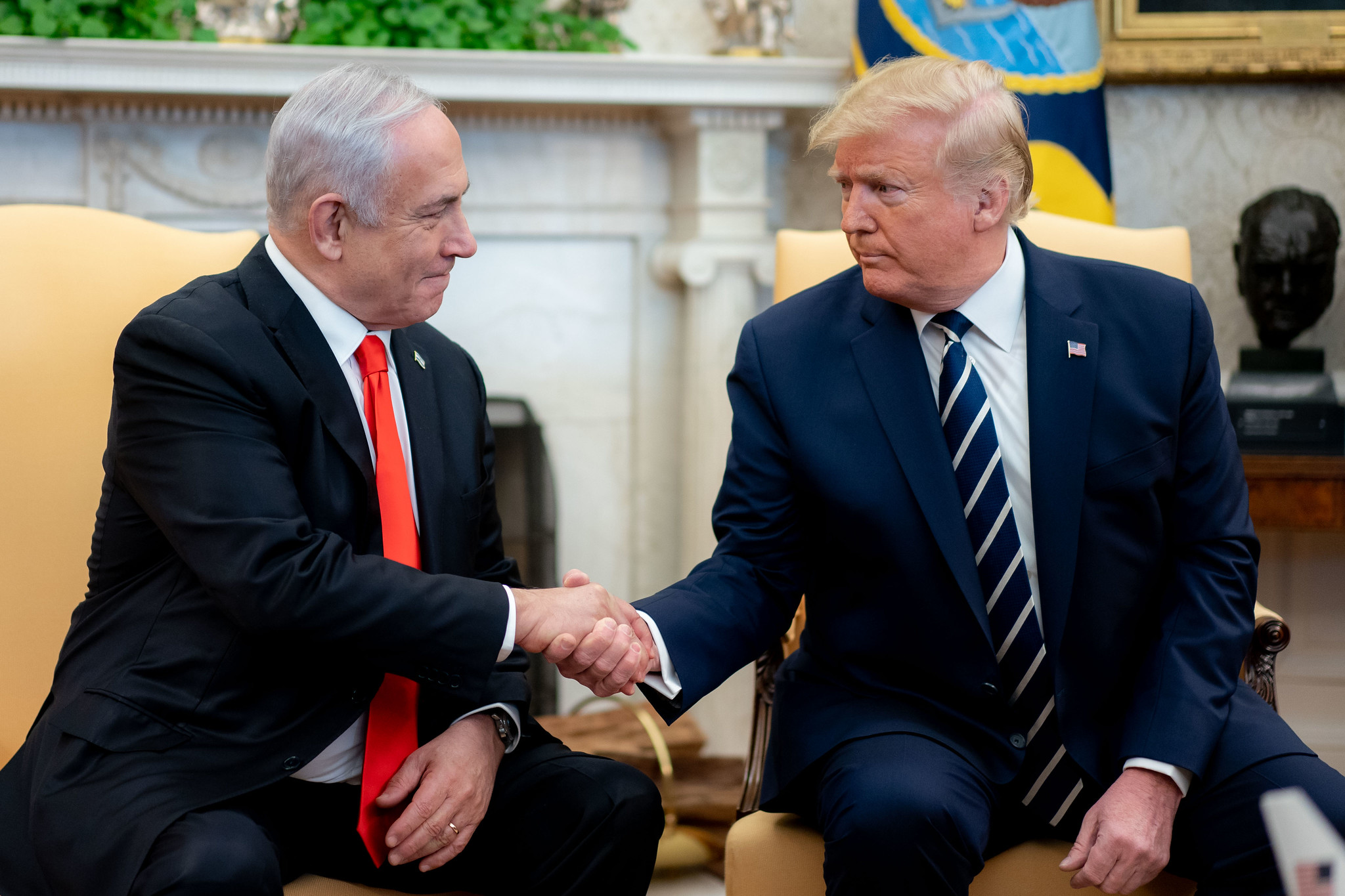Fulfilling the Humane Promise of the Chemical Weapons Convention

Published by The Lawfare Institute
in Cooperation With

In July, the United States satisfied its obligation under the Chemical Weapons Convention (CWC) to eliminate its entire stockpile of chemical weapons. In being the last remaining party to the treaty to possess declared chemical weapons yet to complete destruction, this U.S. act has eliminated 100 percent of the world’s declared stockpiles of chemical weapons. This achievement is a welcome reinforcement of the importance of international law and continued commitments to fulfill the promises of the CWC to ensure a world free of chemical weapons while protecting the peaceful use of chemistry.
Chemical weapons, along with biological, nuclear, and radiological weapons, are categorized as weapons of mass destruction (WMD). By their very nature, these types of weapons are viewed by the majority of nations as inherently presenting a level of suffering that is contrary to the law of war. The principle of humanity underpins the legal framework that makes up that law. That is, in armed conflict, only that level of force necessary to achieve a legitimate political purpose may be used. Weapons of war are not to be used to inflict unnecessary suffering. Accordingly, as the international community began to recognize, these weapons should be eliminated or, in the case of nuclear weapons, at least closely monitored and controlled until a time when they can be eliminated.
The notion of limiting the destructive effects of armed conflict has a long history, and laws aimed at protecting people and avoiding unnecessary suffering are reflected in the body of law known as International Humanitarian Law (IHL). The use of any WMD is contrary to IHL, and under customary international law, the use of chemical weapons is prohibited under all circumstances and is binding on all parties to an armed conflict. The CWC bans the development, possession, and use of chemical weapons and is binding on all states parties. However, the work to limit and ban the use of, and ultimately eliminate, chemical weapons has been a painstaking process spanning hundreds of years.
History of the CWC
The law in this area began to form as early as 1675, when France and Germany signed an agreement to prohibit the use of poisonous bullets in conflict. Nearly 200 years later, the 1874 Brussels Convention sought to create an international framework to prohibit unnecessary suffering during armed conflict. Though the treaty was never ratified, it represented an important step that led to the 1899 and 1907 Hague Conventions, further restricting the use of poisonous weapons deemed to cause unnecessary suffering.
Lethal chemical weapons were used in unprecedented ways during World War I, beginning when German forces released chlorine gas in Ypres, Belgium, in 1915. The Allied powers banded together in a massive surge to develop masks and other protective equipment for frontline forces. Gas warfare added an extra level of complexity to armed conflict, as troops sought to obtain protective equipment and manage accompanying tactical challenges in their efforts to prevail. However, besides having the temporary effect of clearing a localized portion of a front line, the use of these gruesome weapons never resulted in significant tactical or operational gains. But the horrific impact of these weapons did not go unnoticed: More than 100,000 people met their deaths through nightmarish pain and suffering, and more than a million people survived the war with lasting physical ailments.
The widespread revulsion against the use of poisonous gas drove a diplomatic surge that influenced the World War I peace treaty with Germany; the 1919 Treaty of Versailles prohibited the use of poisonous gas and also took the unprecedented step of creating the League of Nations to resolve disputes between nations as well as provide security guarantees, with the noble goal of averting future wars. The prohibition on the use of poisonous gas was reinforced in the 1925 Geneva Protocol, which extended the prohibition to the use of “bacteriological methods of warfare.” In the treaty’s earliest years, 38 nations ratified it, and its influence spread. However, it banned only the use of chemical and biological weapons in war—not their creation or stockpiling. Multiple nations, including signatories like the United States, tested and produced chemical weapons. Also, despite being a signatory, Italy used chemical weapons during its invasion of Abyssinia (now Ethiopia), which was also a party to the treaty.
Throughout World War II, the major powers retained extensive chemical warfare programs, though use on the battlefield was mostly absent. The Geneva Protocol, fear of retaliation, and unfavorable battle conditions all may have contributed to restraint in the use of these banned agents. Nonetheless, chemical weapons derived from Germany’s wartime weapons program were employed to conduct a systematic mass murder of more than six million Jews, as well as Roma, political dissidents, persons with disabilities, homosexuals, and others.
Throughout much of the Cold War, the rules-based international order developed in earnest. Nations placed greater diplomatic attention on preventing widespread proliferation, reversing the nuclear arms race, and outlawing biological weapons. Chemical weapons use in the Iran-Iraq War and Iraq’s horrific chemical attacks on Kurdish populations in the 1980s drove greater urgency to ban chemical weapons as well. These efforts paid off. One hundred and thirty nations signed the CWC when it opened for signature in 1993, and since its 1997 entry into force, all but four countries that are part of the United Nations have ratified the treaty.
Going further than previous attempts to end the use of chemical weapons, the CWC sought the elimination of an entire category of weapons of mass destruction by banning the use, development, production, acquisition, stockpiling, and transfer of chemical weapons. To implement this ambitious agenda, in setting up the CWC, nations also established the Organization for the Prohibition of Chemical Weapons (OPCW).
Upon ratifying or acceding to the treaty, every state party is required to declare whether and to what extent it possesses chemical weapons. If the initial declaration includes such weapons, the declaring state party must allow OPCW inspectors to access all chemical weapons and related facilities for systematic verification of the declaration through on-site inspections. States are further obliged to destroy the weapons in a safe manner consistent with the detailed requirements of the OPCW. Importantly, each state party must cooperate fully on matters pertaining to implementation of the CWC.
In addition to initial and routine inspections, the verification framework provides for challenge inspections, which are designed to shed light on and resolve noncompliance concerns—including allegations of the use of chemical weapons—through short-notice inspections. Any state party can request a challenge inspection against another state party, and the OPCW maintains a sophisticated investigations apparatus to conduct these inquiries.
To facilitate verification and inspection oversight, the OPCW divides chemical weapons into three schedules. Schedule 1 includes chemical weapons with no cognizable commercial application (primarily those agents known to have been used or stockpiled in the past). Schedule 2 includes toxic chemicals and precursors that possess commercial application in small quantities. And Schedule 3 includes toxic chemicals and precursors that contain commercial applications in large quantities. The level of invasiveness of an inspection varies based on a variety of factors, including where the agent falls within these schedules.
Inspections at military facilities and certain commercial chemical plants help further the aims of the OPCW to achieve complete disarmament, prevent renewed development of chemical weapons, and guard against the wrongful use of dual-use chemicals. Continued verification of commercial plants is essential going forward, especially as advances in technology blur the lines between dangerous chemical and biological agents.
By the turn of the millennium, the stage was set for the United States to safely destroy its declared stockpiles of chemical weapons—more than 30,000 tons’ worth, much of it stored for decades in loaded munitions. As of July 7, 2023, the United States completed that goal.
Outside the United States, seven other countries declared stockpiles of chemical weapons: Albania, India, Russia, Libya, Iraq, Syria, and a country that asked the OPCW that its identity remain anonymous. The OPCW announced that Albania had completed destruction of its declared stockpile in July 2007. That announcement was followed by the aforementioned anonymous country announcing complete destruction of its declared stockpiles in 2008, followed by India in 2009, Russia in 2017, Libya in January 2018, and Iraq in March 2018. Syria joined the CWC in 2013, and by 2014 all of Syria’s declared chemical weapons had been eliminated, much thanks to the OPCW-United Nations mission. Based on a separate process under the treaty, other countries destroyed chemical weapons remnants from the world wars in East Asia and Europe. This included some known stockpiles of old, degrading materials, and some that were buried during the wars and occasionally turned up in places like farm fields, near waterways, and on Pacific islands.
Ongoing Challenges With Compliance
Although 100 percent of the world’s declared stockpiles of chemical weapons have been verifiably destroyed, challenges remain. According to the State Department’s 2023 annual report on compliance with the CWC, of the 192 states parties, the U.S. certified four states as being in noncompliance: Burma, Iran, Russia, and Syria. The U.S. assesses that Burma had a chemical weapons program (including a storage facility) in the 1980s, yet when Burma made its initial declaration after ratifying the treaty in 2015, it claimed to have no chemical weapons to declare. The U.S. engaged in extensive diplomatic efforts between the OPCW and Burmese officials to resolve these discrepancies, to no avail. These engagements were paused after the February 2021 coup, and the U.S. continues to assess Burma as noncompliant with the treaty. The assessment of Iran’s noncompliance is based on a range of evidence, including the regime’s own advertisements of its capabilities.
While Russia and Syria completed destruction of their declared stockpiles, each remains bound by the treaty to never under any circumstances develop or use chemical weapons. Despite these ongoing obligations, both appear to have used chemical weapons offensively, raising additional questions about the completeness of previous declarations. The OPCW found that Syria used chemical weapons in 2018 against its own citizens in Douma. After extensive joint investigative efforts with the UN, the OPCW in April 2021 suspended certain rights and privileges of Syria under the convention.
Russia’s noncompliance stems from the targeted use of chemical weapons: first, in 2018 against a former Russian intelligence officer in Salisbury, U.K.; and second, against Russian opposition leader Alexei Navalny in August 2020. Both incidents involved the use of a Novichok nerve agent. At the time of the 2018 incident, Novichok was not on the list of banned chemical weapons under the CWC. In June 2020, the OPCW added four Novichok strains to the list of banned chemicals under Schedule 1. Two months later, when Russia poisoned Navalny, the nerve agent used was also in the Novochok family, though it was not one of the recently added variants. Given that Russia invented Novochok agents, and no other country is known to have researched or developed them, there is little doubt of Russia’s culpability. True to form, Russia has denied responsibility for these incidents and claims it is in full compliance with the CWC.
The noncompliance of these four states parties demonstrates some of the ongoing challenges to fulfilling the promises of the CWC. Potential dual-use facilities also present challenges to the verification process of making sure new chemical weapons are not developed. The U.S. has particular reservations about the compliance of China, Iran, and Russia due to each country’s interest in pharmaceutical-based agents (PBAs) and toxins, and the potential that these substances are being developed for dual use. Continued transparency by states parties and verification and monitoring by the OPCW of industrial chemical facilities will be crucial going forward.
Nonproliferation Challenges More Broadly
We are at an inflection point across all of the treaties that have driven progress in reducing WMD risks, curtailing proliferation, and eliminating these classes of weapons. For chemical, biological, and nuclear weapons, these treaty systems are fragile.
The CWC has shown relative strength. It is nearly universal, and with the U.S. completing the destruction of its stockpile last month, compliance with the convention has, for the most part, held. Its implementation and oversight body, the OPCW, is well respected and has unique assets such as a skilled, independent technical secretariat and an international network of labs accredited to investigate suspected chemical weapons materials. It has adjusted with the changes in WMD use, such as reaching agreement to classify four Novichok nerve agents as chemical weapons after the previously mentioned Russian use of Novichok in Salisbury, U.K. Yet the CWC is still challenged by several factors, including the direct use of chemical weapons over the past decade by Syria and Russia, as detailed earlier, and in a well-publicized assassination by North Korea in 2017, as well as the changing nature of chemical production and its convergence with biology.
The Biological and Toxin Weapons Convention (BWC) was formed without an implementation body or strong verification regime—issues still plaguing its progress. The good news is that the world united to keep the BWC going last year; its intersessional activities have to be agreed by member states every five years, and through 2022 it appeared possible that states would not agree on how to carry the treaty forward. A vital year of diplomatic work leading to that point was distracted by false Russian allegations of biological weapons possession by Ukraine and the United States—part of its WMD-centered information operations campaign. Luckily, efforts to distract from treaty implementation failed, though the BWC still faces a long, tough road for countries to agree on concrete steps for strengthening it.
States parties agreed to extend the Nuclear Nonproliferation Treaty (NPT) indefinitely in 1995, during a wave of successful arms control agreements and unilateral measures of restraint that kept up momentum. Yet many challenges remain. In 2017, the Treaty on the Prohibition of Nuclear Weapons was adopted with the audacious aim of banning nuclear weapons and working toward fully dismantling them. Given the absence from the treaty of all states with nuclear weapons, most NATO countries, and many allies of these countries, the treaty’s effectiveness remains to be seen.
Meanwhile, the bilateral arms control agreements that drove U.S.-Russian (and, prior, Soviet) progress are nearly all dead. Countries not party to the NPT, such as North Korea, Pakistan, and India, are publicly expanding their nuclear stockpiles. Some of the treaty’s recognized nuclear weapons states are expanding their nuclear capabilities or stockpile sizes as well, risking a broader arms race. In 2022, Russia was the sole country that prevented the NPT Review Conference from agreeing to a consensus outcome document. In June 2023, when President Vladimir Putin announced he had moved tactical nuclear weapons to Belarus, Russia became the first country since the signing of the NPT to station nuclear weapons in another country.
In addition to strains across the nonproliferation and disarmament treaties, international norms and the rules-based order are being further challenged. Russia’s invasion of Ukraine has tested the international order in ways unseen since World War II. The invasion itself violated the UN Charter, which prohibits member states from using force “against the territorial integrity or political independence of any state,” and the Budapest Memorandum, in which Russia, the U.S., and the U.K. agreed “to refrain from the threat or use of force against the territorial integrity or political independence of Ukraine” in exchange for Ukraine signing the NPT and eliminating nuclear weapons from the former Soviet Union on its territory. The OPCW is monitoring chemical industrial facilities in Ukraine as well as Russia’s provocations or threats of chemical weapons use in the country.
All of these issues are coinciding, which means the international legal landscape that has largely served the world well for decades is at a critical stage. The United States’s destruction of its chemical weapons stockpile therefore carries outsized importance compared to what might have been the case in years past. In such a fragile moment, the U.S. must continue to vocalize the principles that led to the CWC and related treaties, and showcase how it is working with others to pursue compliance—which will be critical for upholding the international legal order.






